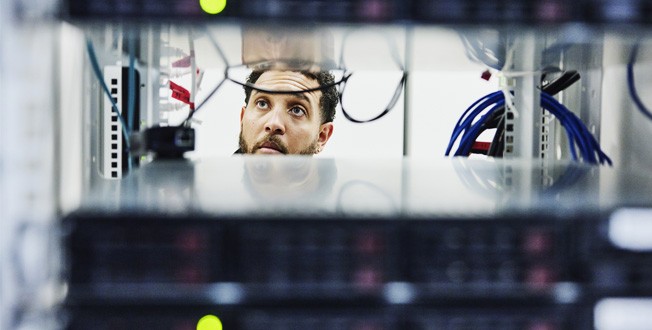Please visit the updated page here: On future paths: network innovations for the next wave of digital innovation
On future paths: Network innovations for the next wave of digital innovation

Digital innovations are set to drive significant economic opportunity over the next few years. How significant? A 2022 CSIRO report on megatrends noted that the next wave of digital innovation will generate $10–15 trillion globally and could contribute $140–250 billion to Australia's GDP by 2025.
There is a confluence of transformative technologies at the heart of this new opportunity.
The first – and most high profile – is artificial intelligence (AI) and its subset of generative AI (GenAI). The rapid consumer adoption of the GenAI-enabled chatbot ChatGPT in 2023 upended the typical expectations for a technology transition. With the launch of Microsoft Copilot, Google Gemini, Adobe Firefly and Sensei, and many others, generative AI is penetrating the workplace too.
The second category is the Internet of Things. Established, proven IoT use cases abound, from smart home consumer devices to commercial asset tracking solutions and automated lysimeters for the agriculture industry. Globally, the latest IoT Analytics State of IoT—Spring 2023 report shows that the number of global IoT connections grew by 18% in 2022 to 14.3 billion active IoT endpoints.
Locally, Australian organisations have been enthusiastic adopters of IoT solutions. Take manufacturing as an example. Research from IDC and Microsoft shows that organisations in Australia report the highest rate of IoT adoption at 96 percent—beating both Italy (95 percent) and the United States (94 percent). Australian mines, for example, have some of the world’s highest penetration of technologies, especially drones, autonomous and remote-control vehicles and mine management software.
It’s perhaps no surprise that cloud is the third technology fuelling digital economic opportunities. Much of the data generated and consumed by these applications will traverse networks and cloud environments. The cloud sector will continue to grow to accommodate this value creation. According to IDC and Microsoft, 85% of business applications will be based on cloud by 2025.
The consequences for networks
The rapid adoption of these technologies will have an impact on how networks are designed, built and operated. Here we break down what the next wave of transformation means for the networks that underpin digital innovation.
What it means for capacity
GenAI tools are growing in capability, application and usage. Analyst Altman Solon calculated the hourly volume of generative AI tasks across four business functions – software development, marketing, customer service, and product development/design. Considering the potential adoption rate per use case, average users per case, and average generative AI tasks per user hour, the analyst firm estimated between 80-130 million generative AI tasks per hour within the next year across these key enterprise functions in the US alone.
Another research firm forecasts 1 quadrillion annual text-based genAI tokens will be used by the end of 2028. That’s 100 times the amount estimated to have been used in 2023. But it’s not just text. OpenAI and Google have multi modal capabilities (including voice and image input). Plus Midjourney and Dall-E already generate images. (Tirias Research)
The growth of image generation is forecast to be significantly higher than text-based genAI at over 400 times today’s volume to over 10 trillion images by 2028. The emergence of video generation will increase compute and bandwidth requirements.
And the growth in video is not limited to genAI. There are proliferating industrial IoT use cases for video-as-a-sensor. Resources firms in remote sites are building and deploying new solutions that use live video feeds to monitor everything from workplace safety to quality control and machinery wear and tear.
Demand for data and connectivity has been on an upward trend for many years and shows no sign of slowing down. Traffic demands on our mobile and fixed networks are growing at over 30% and around 10% per annum respectively. It’s no surprise then that analysts predict global data demand to grow between 24% and 33% by 2031.
What it means for network design, scale and flexibility
Currently the large language models necessary for generative AI are centralised in specialised data centres with the GPU power to produce the outputs.
There is a drive to design and deploy smaller models at the edge to process inference activity. This may be appropriate for customised models, bespoke GPTs, or enterprise specific use cases. However, there are limits. General purpose LLMs are too large currently for mass dispersal to the edge. And the value in general purpose LLMs comes from their wide data sets.
There may be a model where common tasks are dealt with at the network edge, and other use cases are enabled centrally. However, in the near term, technology analyst firm Altman Solon estimates the "the networking impact will be felt most on backbone fibre and metro edge networks" due to training data, inference prompts and model outputs.
As businesses digitise more processes, collect and process data, and adopt automation, it’s likely they will use a distributed architecture with a mix of core and edge compute. More analysis and control functions will take place at headquarters, but much will remain on the network edge to take advantage of proximity and low latency.
Dispersed customers and distributed compute will put focus on network design, deployment and management. Network design, including connections to backhaul networks, then becomes a key attribute as companies and communities seek the most efficient way to operate services.
What it means for resilience & latency
Highly connected, digitised processes can make interruptions highly disruptive, and potentially very costly. Some estimates put the hourly cost of network downtime at more than US$300,000 for 91% of SME and large enterprises. In one survey of mid-sized and large enterprise businesses, 44% of respondents reported that a single hour of downtime can potentially cost their businesses over US$1 million.
As GenAI, IoT and Cloud-enabled applications become more ingrained in our daily lives, our dependence on them is likely to grow. And that means our dependence on the underlying infrastructure will also increase. Network resilience and redundancy becomes a vital priority.
Latency will also be a vital factor in the growth of remote industrial control and monitoring, and other in real time, or near real time use cases. Latency can determine the success of telehealth services such as video patient consultations, or live teaching experiences for remote students. Industrial remote control and safety monitoring depend on users being able to see and act in real time.
How our investments help you become future-ready
Today’s digital economy depends on reliable, high performance digital infrastructure. These foundations of digital services can become a crucial factor in the ongoing viability, competitiveness and value creation of a digital enterprise.
That’s why we are developing products, footprints and capabilities to support you in meeting your requirements and those of your end users.
Capacity and resilience upgrades
We have increased capacity options on our wavelength services. We now offer up to 400Gbps on Intercapital routes, and we plan to continue increasing bandwidth.
Core restoration provides a new resilience option for customers with high-capacity wavelength services. This feature automatically reroutes traffic to an alternate fibre path if an outage occurs on the primary path in the core network. This intelligent software-driven failover typically happens within minutes. This feature is for customers needing more availability than a traditional unprotected service but without all the features of a fully protected service.
New standards for core network speeds
Over the next five years to 2027, Telstra will be boosting its national fibre network, with new fibre paths being installed across the country. The new fibre paths will boost capacity and speed to meet the needs of tomorrow’s connectivity between cities, regional and remote communities.
Using leading ultra-low loss technology and strategically positioned amplification sites, this network will support remote working and education, health services, entertainment, online gaming and IoT applications for mining and agriculture.
see link: Intercity Dark Fibre Network - Telstra InfraCo
Helping you sell more, faster
We continue to make it quicker and easier for our customers to sell solutions built on our services. Unified Access for example enables customers to sell services to tens of thousands of business premises without the need to build any extra infrastructure.
These examples are just a glimpse of how we are investing in our networks, technologies and digital experience to help our customers become ready to thrive in the next wave of innovation.
